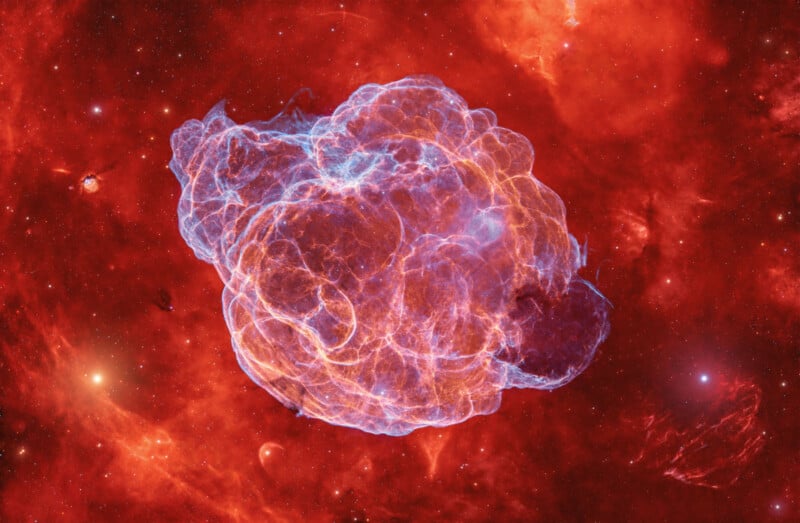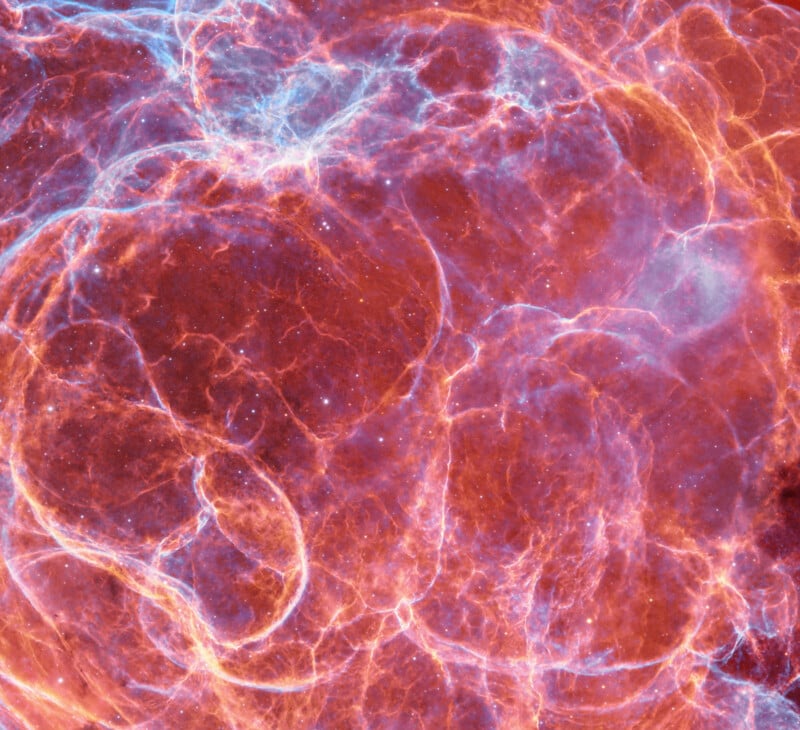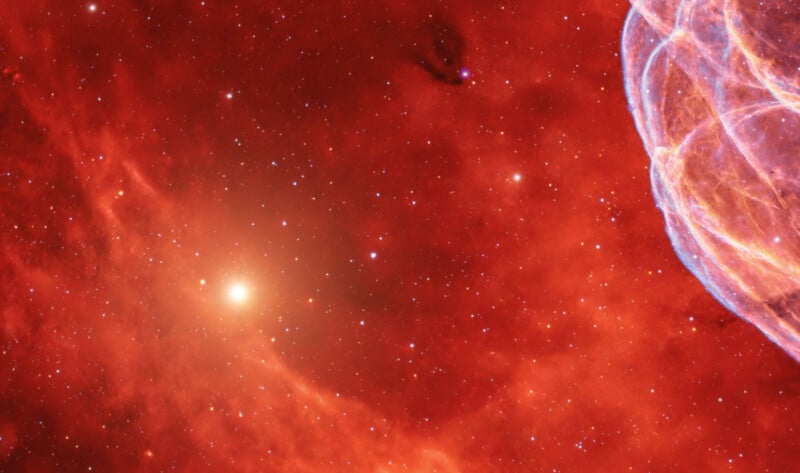Photographer’s Incredible Nebula Photo Took Three Years to Capture

Tennessee-based astrophotographer Jeffrey Horne is an exceptionally talented photographer, capturing photos of deep space that expertly blend science and art. Horne’s latest image of the Spaghetti Nebula (Simeis 147) combines 569 hours of exposure time captured over the past three winters. Few photographic genres test a photographer’s patience quite like astrophotography.
Photographing ‘Spaghetti Nebula and Mars’ for Over Three Winters
“This is a very faint target, and it’s also my favorite night-sky object,” Horne tells PetaPixel of the Spaghetti Nebula. “I love wispy nebulae with fine filaments of structure.”
Horne originally planned to spend two winters capturing exposures of the Spaghetti Nebula. However, when Mars made a “somewhat surprise appearance in the frame,” Horne knew he had to “knock this image out of the park,” so he tweaked his plans and added a third winter of work to his plans.
The longer the exposure time, the less visible the noise and the greater the signal. More exposure time means Horne can “push the data a little farther and expose more faint details without as much noise getting in the way.”
He says there is a point of diminishing returns. However, given that his area in Tennessee has quite a bit of light pollution, it takes him longer to hit that point than it would for astrophotographers in extremely dark places.
“I continued to notice improvements in the data until the very end of collecting my data,” Horne explains. “If I were imaging from darker skies, I could have gotten a similar result with significantly less data.”

Nearly 570 Hours of Exposure Time
To put the over 569 hours of exposure time another way, that’s over three total weeks that Horne’s camera shutter was open, pointed at the Spaghetti Nebula. Since it is such a faint object — it is about as faint as the dimmest stars in the night sky that can be seen by a human eye — it takes a lot of time to capture all the data required to create a final image like Horne’s.
He says one of the greatest challenges was organizing all the data, including multiple calibration frames.
“Pixinsight, though not the easiest software to use, is powerful enough to make this all possible,” the photographer explains.
However, the biggest challenge in total was setting up his camera and telescope rig for 147 different nights over three years.

“I wanted to get as much data as possible, so I would set up my rig even if the forecast was for maybe an hour of clear sky at night. This meant that I would often set up and try to image when it was somewhat cloudy with a chance of rain,” Horne says, adding that the weather at his home in Nashville is “a bit unpredictable.”
Since he wanted to risk it for the chance at as much exposure time as possible, he needed to build a homemade rain detector so he could rush outside to save his gear if the rain turned from a risk to reality. Horne built a rain detector with the aid of an excellent tutorial from Astrolips 2000 on YouTube.
While some of Horne’s peers use remote observatories to image from darker skies, he prefers setting up in his own backyard.
“I love being outside my gear at night, under the stars,” Horne says. He has been conducting wide-field imaging for the past few years and utilized his wide-field telescope for his new Spaghetti Nebula image.
His telescope has a 180mm focal length and a monochromatic image sensor. He uses narrowband filters to isolate different wavelengths of light, including those emitted by hydrogen, oxygen, and sulphur. He also used RGB filters for the stars and Mars.
Since he was working from home, he could also move his rig around in his yard to get as much data as possible.
“This is something that I don’t think many astrophotographers realize or do. As the winter progresses, the time that the Spaghetti Nebula rises and sets behind my treeline changes. By moving my rig to either the East or West side of my yard at the appropriate time of the winter, I was able to get an extra hour of data each night that I wouldn’t have gotten if I kept my rig in one spot,” Horne says.

Image Processing Pushed His MacBook Pro to the Limits
Image capture is exceptionally challenging, but only one part of the equation. Image processing “was a real challenge, as well,” Horne explains.
After tinkering with different color processing techniques, Horne ultimately settled on a “typical SHO channel combination with a FORAXX palette channel combination.”
While technically, astrophotographs like Horne’s are “false color,” that’s a somewhat misleading way to think about it. The color channels he assigned are rooted in reality and how the human eye would perceive the scene, if it were possible to view it. The wavelengths correlate to realistic color channels. While this technique is based on science, many astrophotographers also strive to balance reality with something visually pleasing.
“Processing is very subjective, but I think most of us try to keep our images as close to ‘real’ as possible, “Horne says. “Most of us aren’t doing science work, so it’s not imperative that we keep it scientifically accurate, but we like to try.”
“For me, it’s all about pushing the data as far as I can without creating artifacts,” he adds.
Horne says the final integration of all his images took 58 hours on a high-end MacBook Pro with an M1 Max chip. Although not Apple’s newest machine, it remains very powerful.
“It was a real monster of a data set,” Horne remarks.
Horne Is No Stranger to Very Long Exposure Times
His Spaghetti Nebula image is the largest project he has ever undertaken, but he is no stranger to working with massive data sets.
“I always do long multi-hundred-hour projects,” Horne says, “but usually not more than 300ish hours.”
“I don’t love doing mosaics. I prefer to pump a ton of data into one frame and see what kind of faint details I can reveal.”
He thinks his new shot is tied for his favorite shot in his portfolio.

“It’s tied with the last image I published, The Heart Nebula Widefield. There’s something about the color balance of The Heart Nebula image that I love so much, plus all the tiny planetary nebulae in that image,” Horne says.
“But it doesn’t have all of the fine wispy filamentary structures that the Spaghetti Nebula has.”
A Lifelong Love of the Cosmos
Horne says he got into astrophotography because of his father.
“When I was really young, maybe four years old, he let me see Saturn through his telescope. I was mesmerized,” Horne remembers. “I’ve been fascinated (obsessed?) with astronomy ever since.”
Horne and some of his friends in the astrophotography community discovered a small planetary nebula in one of Horne’s deep integrations, and Horne named it after his dad just before his passing in December 2023.


“One of the last things I was able to tell him was, ‘Dad, we named a nebula after you!'” Horne says. “It was one of the most meaningful experiences of my life.”
Through his passion for astronomy and astrophotography, which was sparked that night when he looked through the telescope with his dad, Horne says he has learned many important life lessons, including patience.
“This type of imaging is difficult. It’s hard to assemble a rig. It’s hard to set up a rig. It’s hard to find targets, focus the scope, and keep it focused throughout nightly temperature changes. It’s hard to even understand where to get started in this hobby,” Horne explains.
However, with years of practice and a lot of patience, he has refined a successful workflow that works for him.

“This hobby is difficult, and without a strong drive to improve, the difficulty can easily overcome you,” Horne adds.
He admits that some of his earliest astrophotography efforts were “awful,” but he loves astronomy and stuck with it. He had the spark needed to dive headfirst into deep-sky imaging, and the results speak for themselves. Hard work and patience can pay off in a big, beautiful way.
Image credits: All images by Jeffrey Horne. More of his work is available on Instagram and Astrobin, and he also sells prints.